Contents
Direct Versus Indirect Provisioning
Required Device Protocols and Software Versions
What Do Companies Use Cisco Prime Collaboration Provisioning for?
I need to roll out one or more sites
I want onsite or regional administrators to handle MACs and password reset
I need to create uniform configurations across one or more clusters
I need to be notified when an event occurs
I need to create distribution lists. Are there any limitations/recommendations?
Analog Voice Gateway and Phone Support
Cisco Prime Collaboration Provisioning Concepts
How to Choose the Synchronization Rules
Domain Sync Rules Interoperability
Configuring Rules Step by Step
Taking Over an Existing Cisco Unified Communications Network
Information for Cisco Prime Collaboration Provisioning Design and Configuration
Configuring Cisco Prime Collaboration Provisioning: Set Up Devices
Configuring Cisco Prime Cisco Prime Collaboration Provisioning: Set Up Service Areas
Configuring Cisco Prime Cisco Prime Collaboration Provisioning: Set Up Administration
Subscriber Services Provisioning: Order, Update, or Change Subscriber Services
Setting Up a New Cisco Unified Communications Network
Typical Problems with Setup and Operation
Dealing with LDAP-Integrated Cisco Unified Communications Manager
Cisco Prime Collaboration Provisioning Synchronization Tips
Tips for Using Cisco Prime Collaboration Provisioning
Enabling Non-RestrictedDomainSync to Reduce the Number of Service Areas
Why Did Some Subscriber Services Show Up in Multiple Locations (Service Areas)?
Why Doesn't the Extension Mobility Service Show Up in the Subscriber Record?
Handling Common Directory Number Mapping Across Multiple Service Areas
How to Manage Phones without Associated Users
Cisco Prime Collaboration page on Cisco.com
Install Guide for Cisco Prime Collaboration
End-User Guide for Cisco Prime Collaboration Provisioning
Cisco Unified Communications Manager
ContentsScope
Introduction
• A converged application with single sign-on, which provides a converged user interface with launch points for both Assurance and Provisioning, or
• Standalone applications with separate login. This mode provides a separate user interface for Assurance and Provisioning features.
Table 1. Terms Related to Cisco Prime Collaboration Provisioning
Provisioning Overview
Installation
Prerequisites
Note: Hyperthreading must be disabled in the server (BIOS level) for better performance of Cisco Prime Collaboration. See your hardware documentation for information about disabling hyperthreading.
Server Requirement
Client Requirement
Preparing for Installation
• IP Address: The IP address of the virtual appliance.
• IP default netmask: The default subnet mask for the IP address.
• IP default gateway: The IP address of the default gateway.
• Default DNS domain: The default Domain Name System (DNS) domain.
• Primary nameserver: The primary name server. You may add the name server. To configure several name servers, enter y.
• Primary NTP server [time.nist.gov]: The primary Network Time Protocol (NTP) server.
To enter a secondary NTP server, enter y at the next prompt.
• Timezone: The time zone set for Cisco Prime Collaboration. When you are prompted to enter the system time zone, specify the default time zone - UTC. You can use SSH to change the time zone after you install the Cisco Prime Collaboration Assurance or Cisco Prime Collaboration Provisioning server; the time stamp that is displayed on the UI is the server time. You must use the same time zone for the Cisco Prime Collaboration Assurance and Cisco Prime Collaboration Provisioning servers in converged mode. For a list of supported time zones, see http://docwiki.cisco.com/wiki/Supported_Timezones_for_Prime_Collaboration.
• Username: Command-line interface (CLI) admin user name. The user name is admin, by default. However, you can specify the user name of your choice.
• Password: CLI admin password. This password is used to log in to CLI to check the application status and perform back up and restore.
• Root user: Superuser who has all privileges in CLI.
• Root password: Specify a password for the root user.
• globaladmin: Superuser who can access both Cisco Prime Collaboration Assurance and Cisco Prime Collaboration Provisioning UI.
• globaladmin password: Specify a password for the globaladmin.
Checking Port Availability
Upgrading Deployments
Licensing the Product
Direct Versus Indirect Provisioning
Required Device Protocols and Software Versions
What Do Companies Use Cisco Prime Collaboration Provisioning for?
Usage by Problem to Be Solved
I need to roll out one or more sites
I want onsite or regional administrators to handle MACs and password reset
I need to create uniform configurations across one or more clusters
I need to be notified when an event occurs
• System settings: Settings to configure notifications for system events like order failures and synchronization failures. Events are aggregated based on type. For example, all synchronization failures will be aggregated in one email and order failures in a separate email.
• Domain settings: Settings to configure notifications for workflow events like order approvals, assignment, shipping, and receiving in the domain. Again, events are based on workflow event type. For example, all approval emails are aggregated together whereas all emails about assignment will be aggregated in a separate email. You can also set an escalation window in the domain notifications template. The value set for the escalation window would make the system send out an email to the system administrators after the time specified if no action was taken for the triggering event (for example, order approvals).
Summary: The email notifications improve the manageability by allowing you to view the critical events like synchronization failures, order failures, and order approvals. See Figures 1 and 2.
Figure 1. Provisioning Notification Management in Standalone Provisioning Setup

Figure 2. Provisioning Notification in Single UI for Assurance and Provisioning Setup

I need to create distribution lists. Are there any limitations/recommendations?
• It is recommended to organize the distribution list in a hierarchy structure. Each distribution list should contain a maximum of 500 members. You can make it nested by having another distribution list as a member under the top distribution list that can again contain 500 members.
• If you are adding members to a distribution list through Cisco Prime Collaboration Provisioning, it supports adding 200 new members in one instance.
• If you are modifying (adding or deleting members) a distribution list through Cisco Prime Collaboration Provisioning, the total number of modifications (removals and additions) in one instance should not be more than 200. For example, if you are removing some members (say X members) and adding new members (say Y members), the sum of X and Y should not be more than 200 members.
• Cisco Prime Collaboration Provisioning does not limit the creation of distribution lists, which may have thousands of members, as long as the add operation is done by adding 200 members each time. However, slow response in the user interface may be encountered when a user views a distribution list that has a large number of members.
Analog Voice Gateway and Phone Support
• Each analog voice gateway registered to UCM is called a voice gateway reference in Cisco Prime Collaboration Provisioning.
• Cisco Prime Collaboration Provisioning supports voice gateways (VG224, VG204, VG202) with Skinny Call Control Protocol (SCCP).
• To provision analog phones from Cisco Prime Collaboration Provisioning.
• To get the voice gateway reference from UCM into Cisco Prime Collaboration Provisioning, perform an infrastructure sync on the UCM to which the analog voice gateway is registered.
• Cisco Prime Collaboration Provisioning also allows addition of voice gateway references into UCM through:
– Infrastructure configuration
– Configuration template
– API
– Batch
• Cisco Prime Collaboration Provisioning supports voice gateways (VG224, VG204, VG202) as an infrastructure product on Communications Manager.
• Cisco Prime Collaboration Provisioning will sync back all the voice gateway references with SCCP during UCM infrastructure sync. See Table 2.
Table 2. Supported Unified Communication Manager Versions for VG Support
|
Product Type |
Protocol |
Supported UCM Versions |
Subunit Value |
|
VG224 |
SCCP |
6.x and later |
24FXS-SCCP |
|
VG204 |
SCCP |
6.x and later |
4FXS-SCCP |
|
VG202 |
SCCP |
6.x and later |
2FXS-SCCP |
• AddAnalog_Phone.txt
• AddAnalog_PhoneService.txt
• ChangeAnalog_Phone.txt
• ReplaceAnalog_Phone.txt
• CancelAnalog_Phone.txt
Move Subscribers and Services
• Subscriber is a pseudo subscriber
• Subscriber has pending orders
• Syncs are running on the subscriber's domain or the devices in that domain
• Deletion is running on the subscriber's domain or the devices in that domain
• Subscriber is being moved from one call processer to another
Localization
LDAP Synchronization
• Cisco Prime Collaboration Provisioning will only read the user information from the LDAP server. Cisco Prime Collaboration Provisioning will not write any information to the LDAP server.
• Only Microsoft Active Directory servers 2000, 2003, and 2008 are supported as LDAP servers.
• LDAP synchronization only creates the users. It does not add their services to their subscriber records. Make sure you run domain synchronization after LDAP synchronization so that the subscribers' services are added to their subscriber records.
• The user search base configured in LDAP services in the domain is used to synchronize LDAP users into the Cisco Prime Collaboration Provisioning subscriber database. While the LDAP user search base is configured when users are added, the authentication, authorization, and accounting (AAA) server is used to authenticate Cisco Prime Collaboration Provisioning subscribers when they log in to Cisco Prime Collaboration Provisioning.
Cisco Prime Collaboration Provisioning Concepts
• Domain
– A logical partition to subdivide a shared environment to create separate local administrative partitions containing service areas with domain partitions and subscribers. A domain can contain multiple service areas and may be associated with multiple Cisco Unified Communications Manager or Cisco Unity clusters.
– Example: A domain could be a company headquarters building or all subscribers in western Europe or each department in a large enterprise.
• Service area
– A logical partition to subdivide a shared environment within a domain to determine the class of service for each subscriber type. Subscriber services are mapped to the devices and application in the voice network. A service area is associated with only one Cisco Unified Communications Manager or one Cisco Unity cluster.
– Example: A service area can be a department within a company headquarters building domain (for example, engineering, marketing, finance, and other departments) or may be tied to a specific location or site.
Figure 3. Domain-Service Area Concept

• Users
– Users are those with authorization to perform various tasks in Cisco Prime Collaboration Provisioning. See Table 3 for more information on user roles.
– Global
– Complete authorization to perform all tasks in Cisco Prime Collaboration Provisioning.
– Cisco Prime Collaboration Provisioning admin (PMAdmin user), created at install, has global administrator rights.
– Domain
– Authorization is limited to tasks within a specific domain or, if using the Multidomain Admin function, one or more domains.
– Users can be assigned more than one user role within a single domain.
– Users can be assigned to manage multiple domains.
– Global administrators: Cisco Unified Communications experts who install the Cisco Prime Collaboration Provisioning application and set up the infrastructure, rules, and policy. They can assign domain admin roles to users.
– Domain admins: Junior help desk technicians who can order predefined service offerings.
– Domain admins with advance ordering privileges: Senior help desk technicians who can set provisioning attributes at time of order.
– Domain admin with infrastructure configuration role: A new domain role to allow nonglobal administrators to provision a specific set of infrastructure configuration objects. Service can be ordered for users. Thus, users become subscribers.
– User roles determine the level of access within Cisco Prime Collaboration Provisioning.
– Some domain-specific roles are applicable only if workflow is enabled.
– Example: A company wants to manage a Cisco Unified Communications network and give day 2 tasks to an IT help desk. In the IT help desk, there are junior and senior technicians. The roles could be as follows:
– Global administrators: Cisco Unified Communications experts who install the Cisco Prime Collaboration Provisioning application and set up the infrastructure, rules, and policy. They can assign domain admin roles to users.
– Domain admin: Junior help desk personnel who can order predefined service offerings.
– Domain admin with advance ordering privileges: Senior help desk personnel who can set provisioning attributes at the time of the order.
– Domain admin with infrastructure configuration role: Senior help desk personnel who can add/edit/view/delete specific sets of infrastructure configuration objects to all call processors in a domain.
Table 3. User Roles
• Subscribers
Entities that use IP telephony services provided by the Cisco Unified Communications System (that is, that have phones, lines, voicemail accounts, and so on).
Subscriber role type defines the products and services that can be provisioned for a subscriber.
Subscriber role types (refer to the User Guide for Cisco Prime Collaboration Provisioning for details):
– Employee
– Contractor
– Manager
– Sr. Manager
– Executive
– Operator
• Subscriber role types can be modified in a global template or on a per domain basis. The products and product bundles associated to a subscriber type can be customized. For example, one can configure the employee subscriber type only to provision phones of type 7961.
• Additional customized subscriber role types can be created in Cisco Prime Collaboration Provisioning.
If Cisco Prime Collaboration Provisioning Self-Care mode is enabled, subscribers can order services for themselves. Thus, a subscriber also becomes a limited user. Self-care can be enabled at the domain level so that all users in a domain have the self-care feature.
• Business rules
Cisco Prime Collaboration Provisioning contains a predefined set of business rules that control processing of orders, behavior of the synchronization process, and default values for various objects. Rules can be set per domain or in a global template assigned to all new domains.
Some commonly used rules (eight domain synchronization rules are introduced later in the section "How to Choose the Synchronization Rules"):
– Domain synchronization rules (see the section "How to Choose the Synchronization Rules" for more details on how to use them)
– AssociateAllUsersInCallProcessor
– AssociateAllUsersInUMProcessor
– AssociateOnlyExistingUsers (1.3)
– AssociateUsersByDeptCode
– AssociateUsersByDevicePool (1.3.1)
– AssociateUsersByLocation (1.3.1)
– TakePrimaryUserInfoFromUMProcessor (1.3)
– Non-RestrictedDomainSync (1.3)
– Workflow rules (see the User Guide for Cisco Prime Collaboration Provisioning for more details):
– IsAuthorizationRequiredForAddOrder
– IsAuthorizationRequiredForCancelOrder
– IsAuthorizationRequiredForChangeOrder
– PhoneAssignmentDoneBy
– PhoneReceiptDoneBy
– PhoneShippingDoneBy
– Rules by problem to be solved:
– Need to remove exchange data when a Cisco Unity account is deleted: Enable PurgeUponUmRemoval.
– Need subscribers to order service for themselves: Enable CreateSelfCareAccounts.
– Don't want help desk to choose phone template when provisioning phones: Disable ChoosePhoneButtonTemplates.
– Want to force a Cisco Unity subscriber to change the password after the password is reset by Cisco Prime Collaboration Provisioning: Enable ChangeUnityPasswordOnNextLogin.
– Need to import a user from Cisco Unified Communications Manager and to assign the subscriber role automatically: Configure the DefaultUserType rule as desired. By default this is configured to be Employee.
– Need to keep a phone number reserved after deleting it from a subscriber for a period of time before reassigning it back into the available numbers block: Enable the DNAutoReservation rule and configure DNAutoReservationTimeout as desired.
– Rules related to default values of provisioning attribute:
– DefaultCallManagerPassword
– DefaultCallManagerPIN
– DefaultCUPMPassword
– DefaultDeviceProfile
– DefaultUnitySubscriberPassword
– DescriptionString
– LineDisplayString
– ExternalNumberMasks
• Set the synchronization rules up for domains before the first sync. (See the section "How to Choose the Synchronization Rules" for more details on how to select domain synchronization rules).
• Leave the default settings for other rules until you gain experience with Cisco Prime Collaboration Provisioning. (Example: Workflow rules can be modified afterward).
• Provisioning attributes
Both call and messaging services have many attributes that can be assigned and that further define and enhance the service provided to the subscriber. For example, one attribute that can be defined on a phone as an enhancement to its use is the setting of speed dials. Within Cisco Prime Collaboration Provisioning, these settings are known as provisioning attributes, and they can be set at multiple levels within Cisco Prime Collaboration Provisioning to enforce policy, again simplifying the overall provisioning of subscriber services.
The provisioning attributes supported by Cisco Prime Collaboration Provisioning are documented in the User Guide for Cisco Prime Collaboration Provisioning.
Provisioning attributes can be set for domains, subscriber types, service areas, and during order entry. This order also defines the default order of precedence in the event that the same attribute is set at multiple levels. Cisco Prime Collaboration Provisioning allows users to reorder the precedence of domain, subscriber type, and service area.
– Let's look at a brief example to help clarify this:
– A policy at Chambers Engineering states that no subscribers in any of the offices in France are to have video capabilities on their phones except the executives.
– One way to implement this would be to set the phone attribute Video Capabilities to Enabled at the domain level and true for the executive subscriber type.
– Now, all orders for phones in the France domain will set Video Capabilities to Enabled, but for subscribers of type Executive, this will be overridden with a value of true.
– If an individual employee is also given clearance for video privileges, the employee's false setting can be overridden during order entry using the Advanced Options button.
• Ordering workflow
Cisco Prime Collaboration Provisioning has a built-in ordering workflow to coordinate activities in the ordering process. The activities include approving the order, assigning a phone to the order, shipping the product, and receiving the product.
This workflow can be customized to fit the customer's exact needs by enabling or disabling each step and assigning the enabled steps to Cisco Prime Collaboration Provisioning user roles.
By default, all steps are disabled. The workflow rules control enabling of any step of the workflow.
• Will fewer technical staff be "delegated" management capabilities for the day 2 (move, add, change) activity for subscriber services (example: a help desk, or administrative staff in various locations)?
• What groupings of subscribers map best to how you want to do this "delegated" management (example: geographic-based groupings or organizational-based groupings)?
– These questions will dictate the number of domains that will be created in Cisco Prime Collaboration Provisioning. Note that users with the domain-level access role (called the ordering role for a single domain within Cisco Prime Collaboration Provisioning) can only see subscribers in their own domain.
• Within each grouping of subscribers, which sites or locations do you want to manage?
• For each site or location, what classes of services are required?
• For each site or location, what device pools, phone protocols, voice mail templates, common device configuration, locations, and partitions are required?
• For each site or location, which devices will support that location?
– These questions will dictate the number of service areas that will be created in Cisco Prime Collaboration Provisioning for that domain. Service areas point to unique combinations of call processors and message processors (example: Cisco Unified Communications Manager and Cisco Unity). They also contain policy information on calling privilege, like calling search spaces within the Cisco Unified Communications Manager to be used for the service area. Directory number blocks can also be defined in service areas.
• Is a single Cisco Unified Communications application (example: Cisco Unified Communications Manager) shared across these groupings of subscribers and locations?
– This question will dictate how basic synchronization rules are set within Cisco Prime Collaboration Provisioning. For example, will Cisco Prime Collaboration Provisioning need to place subscribers into domains automatically at synchronization time based on the department code in the Cisco Unified Communications Manager, or can it put all users it finds into a Cisco Unified Communications Manager single domain?
• It is recommended that the initial deployment of Cisco Prime Collaboration Provisioning focus on defining the correct domains and service areas, provisioning attributes against these, and the basic rules covered in the section "Usage by Problem to Be Solved."
• Try to avoid flat domain/service area design; for example, having one domain with a thousand or hundreds of domains with one service area per domain is not good design.
• Domains can be designed based on delegation needs or geographic location.
• It is recommended to calculate the service areas needed for each domain beforehand. By default, the number of service areas needed will be the permutation and combination of six or seven attributes in the service area setup (class of service, device pool, phone protocols, voice mail templates, common device configuration, location, partition). If the number of service areas needed for a domain exceeds 100, consider breaking into two domains for easier manageability and optimal usability.
• It is easier to create multiple domains and remove some later, consolidating subscribers into fewer domains, than it is to create a small number of domains and later split subscribers into more domains.
• Consider the use of subscriber types, advanced rule settings, and other configuration parameters after these concepts are well understood.
• Set up devices
– Add call processors (Cisco Unified Communications Manager publishers only, when using Cisco Unified Communications Manager clusters) and message processors to Cisco Prime Collaboration Provisioning as devices with capabilities assigned
– Configure call processors and message processors
– Perform infrastructure synchronization
– Perform subscriber synchronization
• Set up domain deployment
– Create domains and assign call processors and message processors
– Create service areas
– Configure rules
– Perform domain synchronization
– For preexisting call processors and message processors, verify that subscribers get created
• Provision network
– Create and push templates to configure Cisco Unified Communications Manager
– Or sync current provisioning configurations from existing deployment
• Set up deployment
– Create new service areas, as needed, for each domain, typically one per class of service
– Assign subscriber types to each service area
• Admin
– Add subscriber types
– Modify products available to subscriber types
– Create administrative users for each domain
– Configure business rules
• Set ordering workflow
– Order, update, or change subscriber services
How to Choose the Synchronization Rules
Domain Sync Rules
If this rule is enabled, during a domain synchronization, all of the user accounts in all of the call processors in the domain are assigned to the domain being synchronized. In the example in Figure 4, all users in the call processor are placed in Domain 1. Sync on another domain will not have any users since all users have been placed in Domain 1. So this rule should be used to control domain sync when only one domain is configured in Cisco Prime Collaboration Provisioning. See Figure 4.
Figure 4. Example: Domain Sync with AssociateAllUsersInCallProcessor
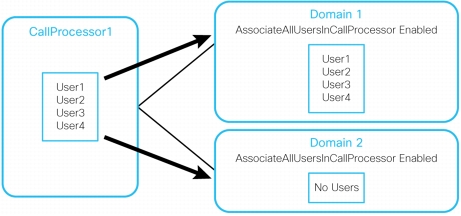
This behaves the same as AssociateAllUsersInCallProcessor. If this rule is enabled, all user accounts in a given Cisco Unified message processor are assigned to a Cisco Prime Collaboration Provisioning domain. This rule can be used to control domain sync when only one domain is configured in Cisco Prime Collaboration Provisioning.
Users are first created in Cisco Prime Collaboration Provisioning in the desired domain. Domain sync associates users in a call processor only if they are already created in the domain. This rule is used only when you want to manually define the user assignment in a multidomain environment or none of other rules meets the requirement. Figure 5 shows an example.
Figure 5. Example: Domain Sync with AssociateOnlyExistingUsers
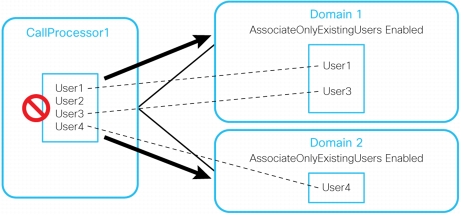
Users created in Cisco Unified Communications Manager with the department code field filled in are associated to the domain based on the value placed in this field. The list of department code values should be enclosed in double quotation marks (") and separated by the semicolon delimiter (;). Department code values may contain wildcards (* or %); for example, "Dept 1";"";"Dept 2";"Dept*3". Figure 6 shows an example.
Figure 6. Example: Domain Sync with AssociateUsersByDeptCode
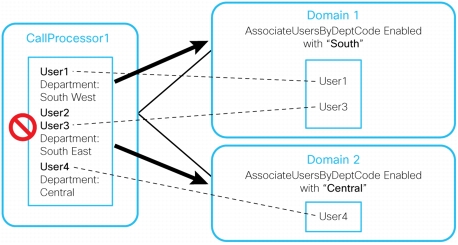
This rule is used to partition users based on the department code in a multidomain environment. If you don't have a department code clearly defined for every user or a department code is not guaranteed to be unique across domains, this rule cannot be used.
Users are associated to a domain based on the device pool setting on the phone. Users are not associated if they do not have a phone. If this rule is set, domain sync will sync only those users that have a phone with the device pool specified in the data field. This rule is applicable only to Cisco Unified Communications Manager, not Communications Manager Express.
Sample data in the rule: "CCM1:DevicePool1";"CCM2:DevicePool2"; CCM1 or CCM2 is the Cisco Prime Collaboration Provisioning call processor name.
With this data, users that have a phone in CCM1 with device pool as DevicePool1 and users that have a phone in CCM2 with device pool as DevicePool2 will by synchronized. If either CCM1 or CCM2 is not part of the current domain, that part of the data will be ignored.
Users are associated to a domain based on the location setting on the phone. Users are not associated if they do not have a phone. If this rule is set, domain sync will sync only those users that have a phone with the location specified in the data field. This rule is applicable only to Cisco Unified Communications Manager, not Communications Manager Express. Sample data in the rule: "CCM1:Location1";"CCM2:Location2"; CCM1 or CCM2 is the Cisco Prime Collaboration Provisioning call processor name.
With this data, users that have a phone in CCM1 with location as Location1 and users that have a phone in CCM2 with location as Location2 will by synchronized.
If either CCM1 or CCM2 is not part of the current domain, that part of the data will be ignored.
If enabled, user and subscriber information is updated from the associated Cisco Unified Message Processor account; otherwise it is updated from the call processor. When the rule is enabled, you can also specify the message processor ID, which takes precedence if a user has accounts on multiple message processors. This value can also be left blank to indicate no preference. This rule is used to handle inconsistent configurations across different call processors and message processors. Figure 7 shows an example.
Figure 7. Example: Domain Sync with TakePrimaryUserInfoFromUMProcessor
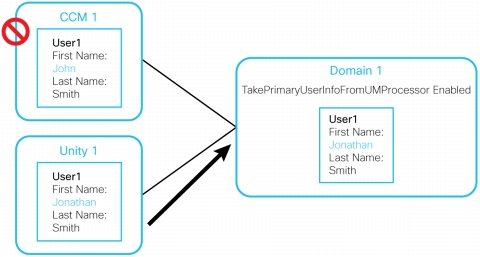
If this rule is enabled, Cisco Prime Collaboration Provisioning performs nonrestricted domain synchronization. Criteria used to find the service area for a product are relaxed to use only a call processor and protocol for the phone product; a call processor for the CTI port, line, enable extension mobility, and enable mobility support products; a call processor and messaging processor for the voicemail, email, and unified messaging products. In addition, only a call processor and messaging processor are used as criteria to match the directory number and voicemail. The user can define a list of service areas to be used. When more than one service area satisfies such criteria, the first matching service area from this list is selected. If no service area is defined or found, Cisco Prime Collaboration Provisioning selects a service area that satisfies the criteria. The service area names should be enclosed in double quotation marks (") and separated by the semicolon delimiter (;), for example, "DefaultSA1";"SA2".
When this rule is disabled, services are assigned to a user only if there are matching service area settings. For phones, Cisco Prime Collaboration Provisioning matches the following attributes: device pool, common device configuration, calling search space of phone, location, and protocol. For lines, Cisco Prime Collaboration Provisioning matches the following attributes: device pool of phone, common device configuration of phone, route partition of line, calling search space of line, location of phone. The domain sync log will show all services that do not have matching service areas.
Figure 8. Example: Domain Sync with Non-RestrictedDomainSync Rule Disabled
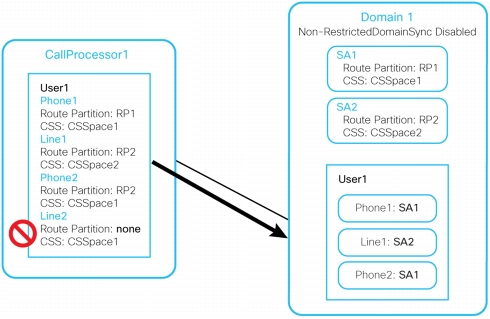
Figure 9. Example: Domain Sync with Non-RestrictedDomainSync Rule Enabled
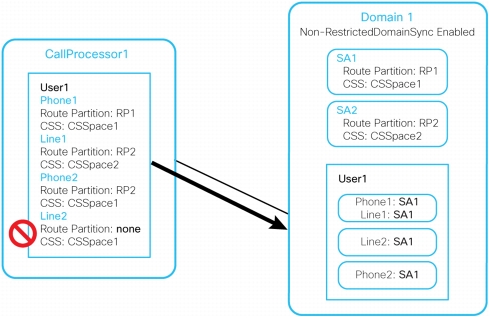
Note: Be aware that if you run a domain synchronization and then change the configured domain rule to Non-RestrictedDomainSync and then run another domain synchronization, any services that were not previously synchronized will be placed in a service area based on the Non-RestrictedDomainSync rule. This could result in services for a subscriber showing up in multiple service areas.
• Rules 1-6 determine how subscribers are placed into the domain.
• Rule 7 determines where information for a subscriber comes from.
• Rule 8 determines how services are matched to service areas in a domain.
• Some rules work in conjunction with others, while some rules are set exclusively.
• The rules AssociateUsersByDeptCode, AssociateUsersByDevicePool, and AssociateUsersByLocation can be used together.
• Once users are assigned to a domain, they cannot be moved to another domain. Users who need to be deleted need to be deleted for the entire domain.
Domain Sync Rules Interoperability
• AssociateUsersByDeptCode: Enabled with data "Dept1"
• AssociateUsersByDevicePool: Enabled with data "CCM2:DevicePool2";"CCM3:DevicePool3"
• AssociateUsersByLocation: Enabled with data "CCM3:Location3"
• CCM1: Users with department code "Dept1"
• CCM2: Users with department code "Dept1" and with phones whose device pool is "DevicePool2"
• CCM3: Users with the department code "Dept1" and with phones whose device pool is "DevicePool3" and whose location is "Location3"
Configuring Rules Step by Step
Step 1. Configure how users are placed in the domain.
• AssociateAllUsersInCallProcessor + AssociateAllUsersInUMProcessor
• AssociateOnlyExistingUsers
• AssociateUsersByDeptCode
• AssociateUsersByDevicePool
• AssociateUsersByLocation
Step 2. Configure how services for a user are assigned to service areas.
• Non-RestrictedDomainSync
(disabled by default)
• AssociateAllUsersInUMProcessor
• TakePrimaryUserInfoFromUMProcessor
Step 1.
• Set the department in Active Directory for users.
• Enable the AssociateUsersByDeptCode rule for each domain and specify the department code.
• Users can be placed using a combination of these rules: AssociateUsersByDevicePool and AssociateUsersByLocation.
• This requires that all users have an associated phone.
• Create subscribers in Cisco Prime Collaboration Provisioning first in the desired domain. The batch action can be used if there are a lot of users.
• Enable the AssociateOnlyExistingUsers rule for domains.
Step 2. Enable the Non-RestrictedDomainSync rule to reduce the number of service areas needed. By default there will be a lot of service areas per domain needed for this customer to cover permutations on different calling search spaces and different device pools.
How to Examples
Taking Over an Existing Cisco Unified Communications Network
Network Description
Information for Cisco Prime Collaboration Provisioning Design and Configuration
• Sites
– 100 physical branch offices in total
– 10,000 IP phones
• Call processors
– Three Communications Manager clusters
– For each of the three Communications Manager publishers:
– Release 8.5
– Lightweight Directory Access Protocol synchronization and authentication
– Extension mobility
• Messages processors
– Three Cisco Unity Connections Version 8.5
• Administrative partitioning
– Based on delegation requirements, users are partitioned into eight administrative sites
• Subscriber services provisioning requirement
– Most users have phone, line, voicemail, and email
– Some users are provisioned with extension mobility (device profile and line) and voicemail
• Dial plan information
– There is one device calling search space per branch office
– There are four line calling search spaces per branch office
– There is one location code per branch office
– There is one device pool per branch office
– There are two common device configurations for all sites
– Only SCCP is used for phones
– Only one voicemail template is used per branch office
– Only one route partition is used for all sites
Configuring Cisco Prime Collaboration Provisioning: Set Up Devices
• Each Communications Manager publisher is entered in Cisco Prime Collaboration Provisioning:
– With extension mobility service and URL
– LDAP integration: Synchronization and authentication
• Three call processors are defined
• Each Cisco Unity Connection(primary Cisco Unity Connection) device is entered in Cisco Prime Collaboration Provisioning. Note: Cisco Prime Collaboration Provisioning doesn't support provisioning backup for Cisco Unity Connection devices.
• Perform infrastructure sync and subscriber sync for each Communications Manager and Cisco Unity Connection.
• Five domains are created, one per administrative site using the UI in Figure 10
• Each domain uses only one call processor and one message processor
• Cisco Prime Collaboration Provisioning allows automatic subscriber synchronization by matching the department code in the directory
• The department code is not guaranteed to be unique across domains
• For each domain, configure the AssociateUsersByDevicePool and/or AssociateUsersByLocation rules in Cisco Prime Collaboration Provisioning to allow synchronization of the subscriber in the domain
• Provisioning attributes: Phone: user_locale: French, Extension mobility access (device profile): user_locale: French
Figure 10. Domain Setup
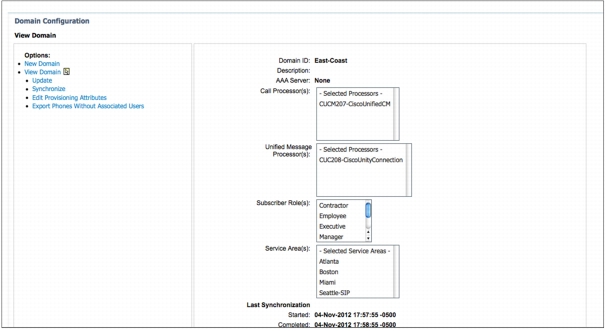
Configuring Cisco Prime Cisco Prime Collaboration Provisioning: Set Up Service Areas
• One service area per site containing:
– One call processor
– Phone Calling Searching Space: Site-specific value
– Line Calling Search Space: Select one out of four
– Common Device Config: Select one out of two
– Location: Site-specific value
– Device pool: Site-specific value
– Router Partition/Protocol: Default value for all sites
– One messaging processor
– Employee subscriber type is selected for the service area
– Directory number block: One predefined block per site to allow autoassignation
– Some provisioning attributes:
– Forward xxx: Set as the same line calling search spaces
– Description (extension mobility line)
• Domain sync needs to be performed before ordering services and after creating service areas.
Figure 11. Service Area setup
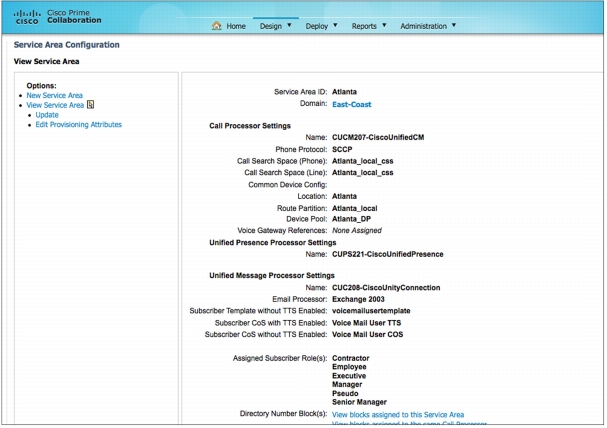
Configuring Cisco Prime Cisco Prime Collaboration Provisioning: Set Up Administration
• Multiple administrators will be defined:
– Some global administrators
– Some administrators per domains
• Workflow rules are not enabled.
• No additional subscriber roles are created, but edit the employee role to associate Unified Messaging Service and Extension Mobility Access with Line.
• Nightly sync is run to make sure that Communications Manager and Cisco Prime Collaboration Provisioning have the same data. For detailed information on scheduling sync, please check the user guide.
Subscriber Services Provisioning: Order, Update, or Change Subscriber Services
• For subscribers, one Unified Messaging Service will be ordered where the administrator will have to choose:
– The domain (only if it's a global administrator)
– The unified messaging service (phone, line, voicemail, and email)
– The line type: Autoassigned line
– Voicemail alias and voicemail display name
– Email ID and display name
– The MAC address
– The service area
– The phone button template
• First order:
– Extension mobility access and line
– The line type: Autoassigned line
– Phone button template
– Some provisioning attribute:
– On the line: Pickup groups, line groups
• Second order:
– Voicemail
Figure 12. Cisco Prime Collaboration Provisioning Ordering GUI
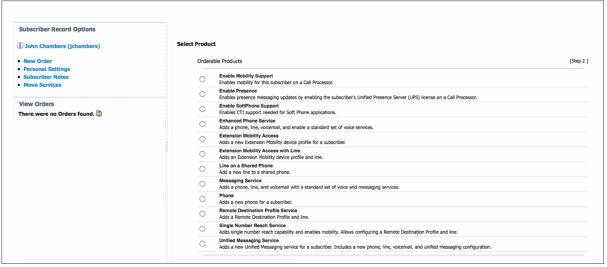
Setting Up a New Cisco Unified Communications Network
• Synchronization (infrastructure sync, subscriber sync, and domain sync) doesn't need to be performed the first time when the call processors, messaging processors, and domains are set up in Cisco Prime Collaboration Provisioning as no configurations/users exist in the call processors and messaging processors. Nightly syncs are recommended to run when users configure Cisco Unified Communications devices with both Cisco Prime Collaboration Provisioning and a native Cisco Unified Communications interface.
• On day 1 of voice deployments, the main activity is to roll out the new branches and cut over subscribers from the older PBX network to the VoIP network. Templates (Figures 13 and 14) can be utilized, so it is best to capture common deployment settings in templates with keywords for devices or site names. For example, with the traditional approach, a customer might have three device calling search spaces (local, international, national) set up for each site. If you have 50 sites, you might end up defining hundreds of calling search spaces repeatedly using the native Communications Manager interface. A Cisco Prime Collaboration Provisioning template can be configured as in the example below (Figure 13) to allow for both consistency and reuse.
Note: The ${KEYWORD} construct allows you to create generic templates. The keyword is defined during configuration.
Figure 13. Cisco Prime Collaboration Provisioning Configuration Template
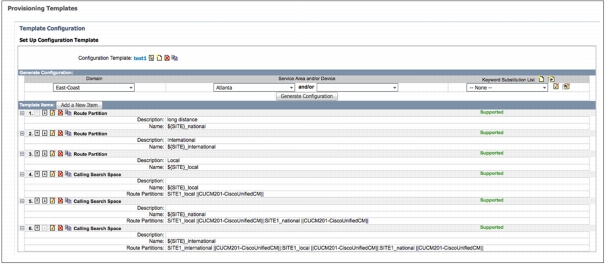
Figure 14. Cisco Prime Collaboration Provisioning Keyword List

• Batches are used to bulk-add new users and move users to help enable easy rollouts of new offices. Cisco Prime Collaboration Provisioning provides sample files that contain most of the commonly used actions. The sample files are located in the /opt/cupm/sep/ipt/config/sample/batchProvisioning folder.
Typical Problems with Setup and Operation
Things to Remember When Using Batch Files
Table 4. Minimum Fields for New Users
|
OrderType |
UserID |
FirstName |
LastName |
Domain |
ProductName |
ServiceArea |
|
Add |
tsmith |
Tom |
Smith |
westcoast |
xxxx |
San Jose |
• OrderType
• UserID
• ProductName
• Domain
• ServiceArea
• Directory Number
• Route Partition
• MAC address is required when ProductName is Phone (or a bundle containing a phone) and Phone Type is not a virtual phone (for example, CTI Port).
• New MAC address is required when changing phones.
• Object name is required when canceling products.
• Phone button template is required when ProductName is Phone (or a bundle containing a phone) or Extension Mobility Access (or a bundle containing an extension mobility access) and Phone Type is not a virtual phone (CTI Port) and when ordered in a service area associated with Cisco Unified Communications Manager only.
• Cisco Unity devices (Cisco Unity, Cisco Unity Connection, and Cisco Unity Express) do not support all products and services. If the batch action file is configured for a product that is not supported by the device in the specified service area, batch provisioning will fail.
• Product attributes that require user input during the manual order entry process are required to successfully complete the equivalent order in a batch project. Examples include:
– Phone Type: Type of phone (for example, Cisco 7960, Cisco 7912) if ordered product is a phone or a bundle that contains a phone
– Line Type: Type of line (for example, autoassigned line or chosen line) if ordered product is a line or a bundle that contains a line
– Directory Number: Required when ProductName is Line and Type is Chosen Line. Additionally, ordering a product with a dependency that is not met by the order itself (for example, ordering a single line) requires a column specifying the dependent object
– Route Partition: Required when ProductName is Line and Order Type is Change
Dealing with LDAP-Integrated Cisco Unified Communications Manager
• dfc.oem.extdir.retries: 24
• dfc.oem.extdir.retry_interval: 3600
• How often Communication Manager does the synchronization from Active Directory (which is configured on Cisco Unified Communications Manager), and
• Whether a synchronization from Cisco Unified Communications Manager to Cisco Prime Collaboration Provisioning is performed to automatically pull in the user to a domain, or whether a user is manually added in Cisco Prime Collaboration Provisioning.
Behaviors for Adding/Deleting Subscribers in Cisco Prime Collaboration Provisioning and UCM (Non-LDAP-Integrated UCM)
Cisco Prime Collaboration Provisioning Synchronization Tips
• When Cisco Prime Collaboration Provisioning encounters an error while in the middle of provisioning:
– Only partially configured information will be saved to the devices.
– Manual configuration is required to the device to complete the provisioning tasks; however, the changes made manually to the device will be resynchronized to the inventory database when Cisco Prime Collaboration Provisioning is back up again and a synchronization is requested.
• What happens when Cisco Unified Communications Manager Publisher fails?
– Will not be able to access any of the information on Cisco Unified Communications Manager server or cluster. It is recommended to add only Publisher to Cisco Prime Collaboration Provisioning.
• It is recommended to run sync at off-peak/midnight hours to avoid impact on both Communications Manager and Cisco Prime Collaboration Provisioning.
• It is recommended to have a nightly sync run to help ensure that Communications Manager and Cisco Prime Collaboration Provisioning have the same data.
• Besides running synchronizations on demand through the appropriate Cisco Prime Collaboration Provisioning UI, you can set up scheduled synchronizations. You must use the Scheduled Tasks functionality that comes with your operating system. For detailed information on scheduling sync, please use documentation in the User Guide for Cisco Prime Collaboration Provisioning at http://www.cisco.com/en/US/docs/net_mgmt/prime/collaboration/9.5/provisioning/guide/Cisco_Prime_Collaboration_Provisioning_Guide_9_5.html Why Am I Not Able to See the Phones and Line Under Some Subscriber Records?
Tips for Using Cisco Prime Collaboration Provisioning
Enabling Non-RestrictedDomainSync to Reduce the Number of Service Areas
• The Non-RestrictedDomainSync always picks up the first service area from the list of service areas in the data field of the Non-RestrictedDomainSync rule and adds the service under that service area. Therefore if you have only one Communications Manager cluster, adding more than one service area to the data field will not have any effect. Only the first one will be used.
• Be aware that if you run a domain synchronization and then change the configured domain rule to Non-RestrictedDomainSync and then run another domain synchronization, any services that were not previously synchronized will be placed in a service area based on the Non-RestrictedDomainSync rule. This could result in services for a subscriber showing up in multiple service areas.
Why Did Some Subscriber Services Show Up in Multiple Locations (Service Areas)?
Why Doesn't the Extension Mobility Service Show Up in the Subscriber Record?
• Make sure you have Extension Mobility Service subscribed for the subscriber.
• Make sure the service name defined in Cisco Prime Collaboration Provisioning is the name of the Extension Mobility Service configured on a call processor.
• Make sure the service URL defined in Cisco Prime Collaboration Provisioning is the Extension Mobility Service configured on the call processor: http://<IPAddress>/emapp/EMAppServlet?device=#DEVICENAME#
Where <IPAddress> is the name or the IP address of the server where Extension Mobility is installed.
Quick Site Builder
Figure 15. Quick Site Builder

Handling Common Directory Number Mapping Across Multiple Service Areas
Working with TAPS
• Update MAC addresses and download predefined configuration for new phones
• Reload configuration for replacement phones
How to Manage Phones without Associated Users
Figure 16. Domain - Export Phone without Associated Users

Table 5. Sample Change Owner Batch File
Note: For optimal usability, it is recommended that you do not assign more than five phones to a single subscriber (pseudo-users or real users).
• Cisco Prime Collaboration Provisioning supports some functions without templates:
– Communications Manager Express: Create users, phones, and lines.
– Cisco Unity Express: Create users and voicemail boxes.
• Cisco IOS template support:
– The Cisco IOS template is a freeform text box that allows commands to be entered and then pushed to the target integrated services router device.
– Commands can have keywords typed in and then a keyword list is created.
– Templates exist in the infrastructure configuration and can be used with any user-assigned keyword.
– Templates also exist as provisioning attributes to phone and line. These templates have predefined keywords FIRSTNAME, LASTNAME, DIRECTORYNUMBER, and USERID.
– A Cisco IOS Software write is executed at the end of each template to save settings on the integrated services router device.
• Caveats for using Cisco IOS templates for Communications Manager Express/Cisco Unity Express/Survivable Remote Site Telephony (SRST)/Cisco IOS devices:
– All CLI commands entered must be syntactically correct.
– Commands (for example, exit) that change the line configuration mode should not be used.
– Do not use line configuration commands (for example, number or description) in this template. They will overwrite the configuration done by Cisco Prime Collaboration Provisioning when provisioning the line product.
– Do not use phone configuration commands (for example; mac-address, description, button, type, or username) in this template. They will overwrite the configuration done by Cisco Prime Collaboration Provisioning when provisioning the phone product.
– Keywords must be unique and not match any Cisco IOS command tokens or settings. It is recommended that keywords be preceded by a dollar sign to assure uniqueness.
– Templates do not have a provision for interactive responses.
– The button command can only support ":".
– Can send integrated services router setup commands for Survivable Remote Site Telephony (SRST) through the CLI template function but must set up SRST on Cisco Unified Communications Manager through the Cisco Unified Communications Manager GUI interface. (No AXL support is provided for provisioning SRST in Cisco Unified Communications Manager using Cisco Prime Collaboration Provisioning).
Frequently Asked Questions
Set-Only is a provisioning attribute that contains a collection of attributes as follows:
• Cisco Prime Collaboration Provisioning only provisions the settings on the device, but does not sync and manage them in the Cisco Cisco Prime Collaboration Provisioning database.
• Cisco Prime Collaboration Provisioning does not support validation for their values.
• Brief description and data format are provided for each Set-Only attribute by the i (information) icon on UI.
• Supported assignment levels are service area, domain, and user type.
• These attributes can be set for phone, line, extension mobility line, and extension mobility access products.
When Cisco Prime Collaboration Provisioning goes to use a directory number out of a DID block, it first checks to see if it is already used (assumption here is that it is in sync with the Communications Manager). If it is used, it skips that one and gets the next number until it finds an unused one. So if users assign a pool of 5000 for autoassignment and 1200 of those were already used, it won't hand out duplicates.
Yes. With Cisco Prime Collaboration Provisioning, users can provision a new phone with settings that are the same as those on an existing phone, except for directory number, MAC, device description, and name-related fields. When a phone is copied, no services (lines, voicemails, or emails) on this phone are copied to the new phone.
Note: Feature is only available to users with advanced ordering role. Batch provisioning and API are not supported for this feature.
No.
Yes. Cisco Prime Collaboration Provisioning can reset Phone PIN, which is also the extension mobility PIN.
If UCM is integrated with LDAP, Cisco Prime Collaboration Provisioning doesn't show an option to change the subscriber password on UCM but will still show an option to change the subscriber PIN on UCM. This is because the PIN is still stored locally in UCM. If the user has services on both LDAP-integrated and non-LDAP-integrated UCM then Cisco Prime Collaboration Provisioning will still show the option to change the subscriber password on UCM but will apply the change only to the UCM that is not integrated with LDAP.
TAPS does not work with Cisco Prime Collaboration Provisioning; it works with UCM. Cisco Prime Collaboration Provisioning can create a phone with a dummy MAC address and provision UCM.
Subscriber plugs in the phone and TAPS manages to collect the MAC and userID. The TAPS server is used to get the MAC into UCM and will switch the real MAC for the dummy MAC. Cisco Prime Collaboration Provisioning will sync in the MACs from UCM. Cisco Prime Collaboration Provisioning will match up the dummy addresses of the phones with the real MACs and put it into the subscriber record. Now UCM and Cisco Prime Collaboration Provisioning will show the correct MAC for the subscriber's phone.
Data transfer is very sporadic, only when requested. Cisco Prime Collaboration Provisioning does not use a lot of fancy graphics or flash presentation. Mouse clicks and typed text are generally passed from the browser to Cisco Prime Collaboration Provisioning and a fairly simple screen is presented back to the browser. In the case of provisioning through the wizard, if the admin does not manually refresh the screen, it will refresh once a minute. When a new screen is requested Cisco Prime Collaboration Provisioning will require between 5000 bytes and 300,000 bytes (300 kilo bytes) to get the new screen. When nothing is being updated on the browser screen bandwidth is essentially zero.
Worst case per admin logged in budget: 500,000 bytes (500 kilo bytes) burst every 5 seconds when ordering services, provisioning infrastructure or doing a search, for the duration of the task.
A 300,000 byte (300 kilo) burst every 1 minute when admin is not using Cisco Prime Collaboration Provisioning occurs only when the admin has left a screen visible that would normally receive an autoupdate (such as a subscriber record); otherwise this is zero bytes per second.
A. During sync
Cisco Prime Collaboration Provisioning will use the available bandwidth so more bandwidth means shorter sync times. Both Cisco Prime Collaboration Provisioning and Cisco Unified Communications Manager have throttling mechanisms to prevent either from overrunning the other. Many large customers deploy one Cisco Prime Collaboration Provisioning and sync worldwide clusters.
B. Provisioning UCM or other UC application
During the actual time provisioning is being done, Cisco Prime Collaboration Provisioning will use the available bandwidth to perform provisioning. Provisioning runs as a background process.
C. Talking to routers
This is Cisco IOS-oriented Telnet-type traffic. it comes in small bursts and uses what bandwidth is available - 2400 bps to 9600 bps is sufficient.
D. All other times
Little or no traffic occurs.
Timeout values are in multiple minutes so loss of connectivity for short periods of time is tolerated. There are no subsecond latency requirements to engineer into your network design to accommodate Cisco Prime Collaboration Provisioning. Cisco Prime Collaboration Provisioning uses a two-phase commit to complete orders, so if an order is in progress when a link failure occurs and subsequently times out, Cisco Prime Collaboration Provisioning will not mark the order complete, rather it will attempt to provision the order again; when the link is reestablished Cisco Prime Collaboration Provisioning will start the order again. When complete it marks the order complete.
Appendix
Cisco Prime Collaboration page on Cisco.com
Install Guide for Cisco Prime Collaboration
End-User Guide for Cisco Prime Collaboration Provisioning
Cisco Unified Communications Manager